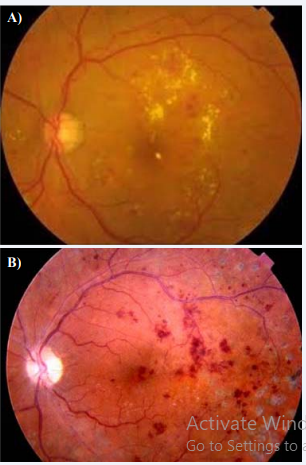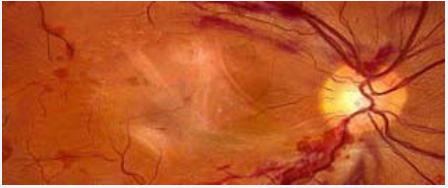Diabetic Retinopathy and Hypertension
- 1. Università di Roma La Sapienza, Facoltà di Medicina e Odontoiatria, Italy
- 2. Scientific department, Sooft Italia SpA, Italy
Abstract
Diabetes is a metabolic disease characterized by impaired control of blood sugar, and often associated to systemic hypertension. Both conditions – hyperglycemia and hypertension –are independent risk factor for the insurgence of one of the most dreadful side effects of diabetes, i.e. diabetic retinopathy. In this short review we describe the relationship between diabetes, hypertension and retinopathy, and give some hints about possible strategies to control or attenuate the risk of developing such condition.
Keywords
- Hypertension
- Diabetes
- Retinopathy
- Food supplements
Citation
Pescosolido N, Rusciano D (2015) Diabetic Retinopathy and Hypertension. Ann Clin Exp Hypertension 3(2): 1022.
ABBREVIATIONS
PKc: Protein Kinase c; VEGF: Vascular Endothelial Growth Factor; ACE: Angiotensin Converting Enzyme; RGC: Retinal Ganglion Cells; AGEs: Advanced Glycosylation End-products.
INTRODUCTION
Diabetes is a systemic metabolic syndrome, in which high levels of blood glucose may be due to either a deficiency of insulin production (type I or insulin-dependent diabetes), or to a peripheral resistance to insulin action (type II or non-insulindependent diabetes). The resulting hyperglycemia leads to the activation of a series of events, such as the polyol pathway, the non-enzymatic glycosylation of proteins with formation of AGEs, the activation of the diacyl glycerol-PKc pathway, oxidative stress and inflammation [1]. These events in turn lead to blood vessels degeneration, resulting in the characteristic macro and micro angiopathy of diabetes patients. The macro vascular complications affect the large vessels of the heart, brain and the periphery, whereas the micro vascular disease involves the capillaries of the kidney, retina and peripheral nerves, causing the respective pathologic damages. The pathogenic link between high blood glucose and diabetic retinopathy has been clearly shown by two clinical studies: the DCCT [2] and the UKPDS [3] studies addressed the role of blood sugar control respectively in type I and type II diabetes patients. Both studies concluded that diabetic retinopathy onset and progression could be delayed by a tight control of blood sugar levels.
Figure 1 A: Non proliferative diabetic retinopathy with yellow exudates and micro aneurisms. B: Advanced non proliferative diabetic retinopathy with micro hemorrhages and micro aneurisms. The effects of laser treatment are visible in the periphery.
Diabetic retinopathy is among the principal causes of vision loss, above all in working-age subjects [1]. It can be distinguished in an early, non-proliferative form (Figure 1), and a more advanced, proliferative form (Figure 2). Arterial hypertension is nowadays recognized as an important risk factor for the onset and successive progression of both forms of diabetic retinopathy [4].The altered auto regulation of the retinal vessels in response to increased systemic pressure values has an important role in this association, in as much as diabetic patients with hypertension seem to have a lesser capacity to modulate the retinal blood flow with respect to non-diabetics [5]. In this respect, the reninangiotensin system (RAS) that is involved in the local control of the blood pressure is widely represented in the retina, and it has been shown to be also involved in retinal pathologies [6]. In diabetics, hypertension can cause endothelial damage to retinal vessels [7] and an increased retinal expression of VEGF receptors [8].
Figure 2 Proliferative diabetic retinopathy: close up of the macular region with peripapillary hemorrhages.
However, early clinical studies failed to find an association between arterial hypertension and diabetic retinopathy [9], whereas the same group of authors in a later report found that a reduction of hyperglycemia and hypertension may indeed result in a beneficial decrease in the progression to proliferative retinopathy [10]. Further clinical trials gave consistent and clear proof of the role of arterial hypertension in the onset and progression of diabetic retinopathy [11]. The UKPDS study [12] addressed the results of treatment of hypertension associated with optimal control of blood glucose. In fact, during the UKPDS study 1148 hypertensive diabetic patients were enrolled, whose blood pressure values were greater than 160/94 mmHg. Among these, 758 patients were allocated to tight control of blood pressure (arterial pressure less than 150/85 mmHg with the beta blocker atenolol, or the ACE inhibitor captopril) and 390 patients to less tight control (arterial pressure less than 180/105 mmHg), with a median follow up of 8.4 years. In the patients who underwent the tight pressure control regimen there was a significant 37% decrease of the risk of micro-vascular complications, as well as a 34% reduction of the risk of progression of diabetic retinopathy and a 47% reduction of the risk of worsening visual acuity.
Atenolol and captopril alone have shown the same efficacy in reducing the risk of micro-vascular complications: after six years of follow-up, the subjects who had an initial systolic arterial pressure > 140 mmHg developed diabetic retinopathy three times more frequently than those who had a basal systolic pressure of < 125 mmHg [4]. This indicates that the effects of arterial pressure control were independent of glycaemia, and suggests that the decrease of arterial pressure in itself is more important than the type of drugs used through which it is achieved. It appears that for every 10 mmHg of arterial pressure reduction, the risk of diabetic retinopathy decreases by 10% [12].
In general, therefore, the results of the above cited epidemiological studies and clinical trials suggest that the treatment of arterial hypertension in subjects affected by diabetes mellitus contributes to prevent the onset of retinopathy and other micro-vascular complications. Moreover, the reduction of arterial pressure could reduce the risk of the onset of retinopathy also in normotensive diabetics [11].
In a further study conducted on normotensive patients affected by type 1 diabetes mellitus, with normal albuminuria or micro-albuminuria, the treatment with ACE inhibitors reduced the risk of retinopathy progression by 50% in two years. The progression to proliferative retinopathy was reduced by 80% with respect to controls [13]. This study suggests that the ACE inhibitors could have an additional positive effect, independent from the reduction of arterial pressure (that was in the normal range both in the treatment and the placebo group), in the prevention of diabetic retinopathy. The authors speculate that this effect could be caused by a more favorable hemodynamic retinal profile, an increased production of nitric oxide, a reduced endothelial dysfunction, a block of VEGFS and a reduction of the activity of metallo proteases. On the contrary, the micro vascular changes occurring in diabetes and hypertensive retinopathy could converge to give rise to ischemia and finally apoptosis of various cell types, among which are pericytes, endothelial cells and neurons [14]. A very recent Cochrane metanalysis [15] concluded that the reduction of blood pressure has a certain beneficial effect on the onset of DR for up to 4-5 years, whereas the effects on its progression during the same time extension were much less evident.
Diabetes, similar to arteriolar hyper tonus, affects the morphology and physiology of RGC, inducing edema of the axons and shrinkage of the dendrites. These modifications, besides occurring in diabetes and hypertensive retinopathy, seem to be a common response of RGCs to other pathologies, such as glaucoma [16], and suggest that similar molecular mechanisms could be responsible for these different pathologies.
Finally, it appears evident from all the cited papers that the primary care for this type of patients must be the treatment and the control of the hypertension and the blood sugar. However, a secondary care could be also considered, based on the observation that most of the damage derived from hypertension and hyperglycemia derives from oxidative stress [17-19]. Therefore, the administration of food supplements designed to specifically counteract the toxic effects of free radicals could attenuate the signs of diabetic retinopathy, giving protection to the circulatory and the neural system. Lipoic acid, for instance, is a biologic antioxidant that intervenes in the restoring of the activity of other antioxidants such as vitamins E and C, besides being a modulator of the signaling transduction of several pathways. It has shown positive effects in the treatment of several pathological conditions linked to oxidative stress and mainly in the treatment of diabetic peripheral neuropathy in patients with type 1 as well type 2 diabetes [20]. The dry extract of Ginkgo Biloba leaves has striking haemorrheological effects [21], which may be particularly useful in diabetic patients affected by retinopathy. A clinical study on 25 patients with type II diabetes treated for3 months by oral administration of Ginkgo Biloba extract resulted in a significant decrease of both malondialdehyde levels in erythrocytes membranes and fibrinogen levels; besides, it promoted erythrocytes deformability, and improved blood viscosity and viscoelasticity, thus facilitating blood perfusion. In fact, it effectively improved retinal capillary blood flow rate in those patients with retinopathy [22].Carnosine has been reported to decrease the non-enzymatic glycosylation of proteins, that is at the roots of AGEs formation in diabetic patients [23]. The association of this three products (alpha-lipoic-acid, Ginkgo Biloba extract and carnosine) with other compounds with antioxidant and antinflammatory properties (selenium, rich berry and white willow bark extract) has been shown to attenuate the degree of retinal inflammation and plasma lipid peroxidation, preserving the retina in early diabetic rats [24] and in diabetic patients with early signs of retinopathy (Gagliano C., personal communication). In conclusion, diabetes and hypertension are two predominant risk factors for retinopathy that may concur in the development and likely the progression of this invalidating disease. Therefore, the simultaneous control of both the blood sugar levels and the blood pressure should be implemented in this type of patients, in order to minimize their risk of development and progression of DR. A healthy regular diet and lifestyle are also necessary to counterbalance these risk factors. An appropriate nutrient supplementation could also contribute to decrease such risks.
ACKNOWLEDGEMENTS
Critical proofreading of the manuscript by Antony Bridge wood is greatly appreciated.
REFERENCES
11. Wong TY, Mitchell P. The eye in hypertension. Lancet. 2007; 369: 425- 435.
18. Hirata Y, Satonaka H. Hypertension and oxidative stress. Jpn. Med. Ass. J. 2001; 44: 540–545.








































































































































